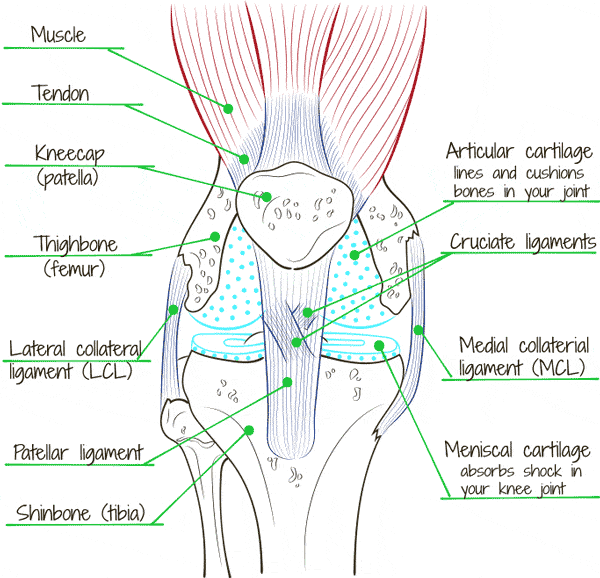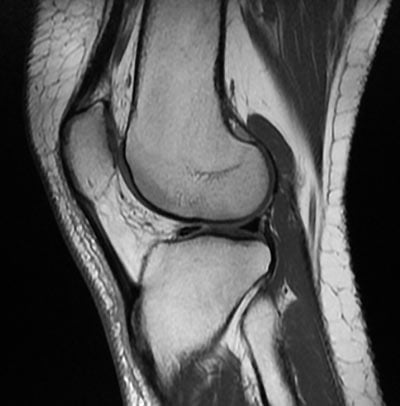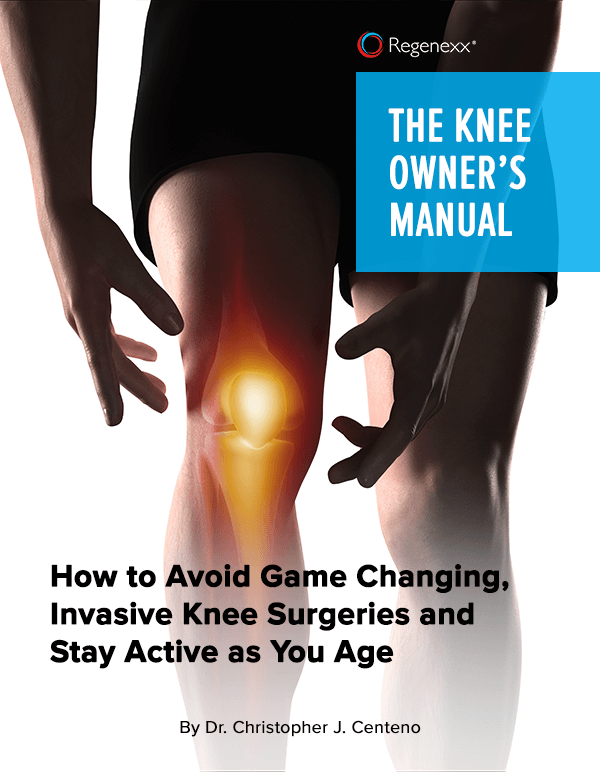Non-Surgical Knee Treatment In New York
Are You a Regenexx Candidate?- Knee
- Meniscus
- Osteoarthritis
- ACL
The Rehabilitation Medicine Center of New Jersey in New York, NY offers Regenexx procedures as a non-surgical option for individuals experiencing knee pain due to arthritis, meniscus injuries, ACL strains, and other soft tissue concerns.
These image-guided procedures use the body’s own platelet-rich plasma (PRP) and bone marrow concentrate (BMC) to support tissue repair, improve function, and potentially help patients avoid or delay surgery.
Regenexx Knee Procedure Options At Rehabilitation Medicine Center Of New Jersey
The Knee Owner’s Manual
How to Avoid Game Changing, Invasive Knee Surgeries and Stay Active as You Age
If you’ve been told that surgery or steroid injections are your only options, Regenexx procedures may offer a less invasive path forward. Physicians at our New York clinic use Interventional Orthopedics, precise, image-guided injections of biologics prepared from your own body, to target areas of damage in the knee joint.
Emerging research has shown that several widely performed orthopedic knee surgeries, including meniscectomies, may offer no more benefit than placebo or sham procedures. Knee replacement surgery is a significant intervention, often followed by an extended recovery period involving discomfort and physical rehabilitation. In some cases, surgery may accelerate joint degeneration, contributing to osteoarthritis and compounding the issues it was intended to address.
The Regenexx approach, offered at Rehabilitation Medicine Center of New Jersey, was developed as a non-surgical alternative for individuals dealing with knee injuries or degenerative conditions. Known as Interventional Orthopedics, this method uses advanced imaging (fluoroscopy and ultrasound) to guide the precise placement of concentrated cells derived from your own body into specific areas of joint damage.
These image-guided procedures using Regenexx lab processing may help improve joint function and reduce pain without the need for invasive surgery. Treatments are performed on an outpatient basis, with customized orthobiologic solutions placed directly into the areas of damage to help stabilize and support the knee joint.
This level of precision and specialized care requires advanced training. Physicians performing Regenexx procedures at Rehabilitation Medicine Center must complete third-party training and adhere to standardized protocols to ensure the highest quality of care.
Get Back To Movement Without Knee Surgery
Imagine walking through the park with your child, grandchild, or dog when your knee suddenly locks or gives way. You lose balance, feel a sharp pain, and struggle to put weight on your leg.
Whether your knee pain is new or longstanding, the daily limitations can be frustrating. At the Rehabilitation Medicine Center of New Jersey in New York, our team can help you understand what’s happening in your knee and explore appropriate non-surgical options.
What Are Common Causes of Knee Pain?
A variety of conditions can lead to knee pain, including:
- Fractures or joint dislocation
- Ligament injuries
- Cartilage damage, such as a meniscus tear
- Knee bursitis
- Tendon inflammation or tears
- Pain linked to biomechanical factors
- Osteoarthritis or other forms of degenerative joint disease
Before diving into specific conditions, it helps to understand how the knee joint functions and how different structures within it work together to support movement.
Knee joint anatomy

The knee joint functions like a hinge, similar to how a door opens and closes. However, unlike a door, the knee allows for limited rotational movement to accommodate more complex motion. It connects the femur (thighbone) to the tibia (shinbone) and includes the patella, or kneecap, which acts as a protective cover at the front of the joint.
The knee can extend to 0 degrees and flex (bend) to about 135 degrees. While it functions mainly as a hinge, it is more limited than the hip and shoulder joints, which are ball-and-socket joints that allow for motion in multiple directions—like arm circles or side-to-side leg movements.
Acute knee injuries often happen when the joint is forced into unnatural positions, such as twisting motions, direct impacts from the side, or ongoing misalignment. Contributing factors may include muscle imbalances, worn or poorly fitting footwear, or excess body weight.
The knee is also a weight-bearing joint, designed to handle the impact of each step. Walking and running produce different levels of force; the impact from running is significantly greater. When combined with higher-than-average body weight or years of repetitive stress, this can lead to structural damage, including cartilage wear, inflammation, and joint degeneration, commonly associated with osteoarthritis.
Knee pain may stem from an acute (sudden) injury or from chronic wear and tear that has not had the opportunity to heal properly.
Parts of the Knee Joint:
The knee joint is composed of several key structures: bones, cartilage, ligaments, tendons, and bursae (fluid-filled sacs). Each of these components plays a specific role in maintaining joint function, absorbing impact, and enabling movement. Together, they allow you to walk, bend, climb stairs, and perform daily tasks that require both flexibility and stability.

Bones: The knee includes three main bones: the femur, tibia, and patella. The ends of the femur and tibia are known as condyles—rounded projections that form the articulation. The medial condyle is on the inner side of the knee; the lateral condyle is on the outer side.
Cartilage: The meniscus is a well-known cartilage structure in the knee. It acts as a cushion between the femur and tibia, reducing friction, distributing body weight, and absorbing shock during activity. Each knee has two menisci—one medial (inner) and one lateral (outer). In addition to meniscal injuries, osteoarthritis occurs when the cartilage cushioning at the ends of bones wears down over time.
Bursa Sacs: Bursae are small fluid-filled sacs that reduce friction between bones and soft tissues like tendons and muscles. These structures help protect the knee during repetitive movement, such as walking or running, by preventing excessive rubbing.
Ligaments: Ligaments are strong connective tissues that stabilize the knee. The anterior cruciate ligament (ACL) is located at the front of the joint, while the posterior cruciate ligament (PCL) sits at the back. These ligaments help keep the femur and tibia aligned and support the knee during movement.
Tendons: Tendons connect muscles to bones and are essential for motion. The quadriceps tendon links the large thigh muscle to the patella, while the patellar tendon connects the patella to the tibia. These tendons play a vital role in bending and straightening the knee during activity.
Treatment Options For Knee Pain in New York
What can I do to reduce knee pain from injury?
To effectively reduce knee pain, identifying the true cause is key. Whether your issue stems from injury, arthritis, or long-term wear, physicians at our New York location can evaluate your symptoms and recommend appropriate non-surgical solutions, including image-guided Regenexx procedures.
Some knee problems may respond well to rest or targeted exercises guided by a physical therapist. Others, however, may require more advanced evaluation and care, especially when pain persists or function does not improve. While surgery is sometimes presented as a first option, it’s important to approach that recommendation with caution. Research has shown that several commonly performed procedures, such as arthroscopic “cleanups”, may not provide lasting benefit and can even lead to poorer outcomes over time.
At Rehabilitation Medicine Center of New Jersey – New York, NY, physicians trained in the Regenexx approach are skilled in diagnosing and treating knee conditions using non-surgical, image-guided procedures. In some severe cases, surgical intervention may still be necessary, but many individuals may benefit from exploring less invasive options first.
What does knee arthritis pain feel like?
Arthritis refers to inflammation within a joint. One common type, osteoarthritis (OA), is often called “degenerative joint disease” due to its progressive nature. While OA can affect several joints throughout the body, it frequently impacts the knees, hips, hands, and spine.
Symptoms of knee arthritis generally appear gradually and may worsen over time. Although the likelihood of developing OA increases with age, especially after age 45, it can occur at any age. Individuals with knee arthritis may experience stiffness, joint swelling, and discomfort. Some also report hearing cracking or popping sounds when moving the knee.
Knee pain related to arthritis may feel like weakness or instability, sometimes described as the knee “buckling.” In some cases, cartilage fragments or other tissue debris within the joint can cause the knee to temporarily lock during motion. Both joint buckling and knee locking may elevate the risk of falls or sudden injury to the knee.
Pain and swelling can often be more pronounced after extended periods of inactivity, such as in the morning or after prolonged sitting. Some individuals also notice that their symptoms worsen in humid or rainy weather.
What can be done to help reduce knee arthritis pain?
Reducing pain associated with knee arthritis often involves a different approach than addressing an acute injury. Because arthritis is typically a chronic condition that develops over time, effective management may also require a long-term strategy.
Knee arthritis may result from persistent uneven loading or joint stress that occurs without allowing the joint space to recover adequately. This ongoing imbalance can contribute to the gradual breakdown of the protective joint structures.
While pharmaceutical options are commonly used to temporarily relieve pain symptoms, they may be associated with side effects or long-term health concerns. Some individuals instead consider options that support the joint’s natural environment, aiming to promote healing and address the mechanical issues contributing to uneven joint stress.
That’s where procedures using Regenexx lab processes may offer an alternative.
While joint replacement surgery is sometimes considered for individuals with advanced knee arthritis, it involves the removal of the natural joint and is a significant, life-altering intervention. For some, this type of surgery may be avoidable by first exploring less invasive options that aim to reduce pain and support joint function.
The Rehabilitation Medicine Center of New Jersey in New York contributes to Regenexx’s national outcomes database, tracking thousands of patients who have undergone knee
Local patients have reported functional gains and decreased pain using this approach, often without undergoing invasive surgery. Our New York team uses these insights to refine care strategies and support recovery. More than 22,672 individuals who underwent knee procedures using Regenexx lab processes are currently being monitored through the Regenexx® Provider Patient Registry.
More details:
How To Support Knee Joint Health
Our care at the Rehabilitation Medicine Center of New Jersey – New York, NY includes guiding patients not just through procedures, but through strategies for long-term joint wellness.
Your recovery may be influenced by factors like sleep, nutrition, smoking, and activity. Optimizing these areas supports the body’s natural ability to maintain and heal joint tissue, especially important in a fast-paced city environment like New York.
Several factors under personal control may influence how well the body responds to injury or chronic joint stress, including:
- Tobacco use
- Alcohol consumption
- Sleep quality and duration
- Regular physical activity
- Nutrient intake and digestive health
- Response to psychological and environmental stress
These elements can either support or limit the body’s natural healing response and may influence recovery from both acute injuries and chronic conditions such as joint degeneration.
Even when these health factors are optimized, such as avoiding tobacco, moderating alcohol use, getting adequate sleep, engaging in consistent low-impact exercise, and maintaining a balanced diet, there are situations where additional support may be beneficial.
That’s where procedures using Regenexx lab processes may offer support. . .
How Regenerative Medicine Can Help With Knee Pain
Many patients in New York are looking for alternatives to long recoveries, surgical complications, or repeated cortisone injections. At the Rehabilitation Medicine Center of New Jersey in New York, physicians perform Regenexx procedures as a minimally invasive option to support joint health and reduce pain.
Using your biologics, precisely prepared and injected, this method seeks to stimulate repair at the site of injury, without surgical removal of joint tissue or the risks of implants.
One of the challenges with surgery is the degree of trauma involved. Instruments like wires, cutters, and mallets, tools more at home on a construction site, are used during procedures referred to as surgical reconstruction. Recovery from such intervention may take months or even a year or more to regain balance, strength, and range of motion. In many instances, the joint may never feel completely restored.
Knee surgery, particularly joint replacement, also introduces permanent foreign materials into the body. Much like how the body reacts to a splinter, these materials are not recognized as part of the body’s natural cellular structure. The body often responds with inflammation to isolate or remove what it sees as foreign, and pain is the signal that something is not right.
The Regenexx patented protocol may support the body’s healing response by focusing repair activity at the site of tissue damage. Instead of attempting to replicate natural processes through synthetic drugs, this approach uses your body’s cells, processed in a Regenexx lab, and delivers them precisely to the affected area, such as the knee.
This method is known as interventional orthopedics (sometimes referred to as regenerative orthopedic medicine). It has been used to help tens of thousands of individuals experience greater mobility and reduced discomfort, often avoiding the need for invasive surgery.
At Rehabilitation Medicine Center of New Jersey – New York, NY, this protocol is used as part of a non-surgical treatment option for knee pain and related joint conditions.
Physicians in the licensed Regenexx network are among the most skilled in the field of interventional orthopedics and have extensive training in performing these advanced image-guided procedures.
Complete the Regenexx Candidate Form to see if this approach may be appropriate for your needs.
Regenexx Benefits
- Increased function
- Pain reduction
- Most individuals do not experience extensive downtime
- Minimal time off of work
- No surgery
- Minimal use of mobility tools (crutches, etc.)
- Minimal disruption of regular routine
131 West 35th Street
12th Floor
New York, NY 10001
Request an Appointment
Call to Schedule Schedule OnlineClinic Hours
| Sunday | Closed |
| Monday | 8AM–8PM |
| Tuesday | 8AM–8PM |
| Wednesday | 8AM–8PM |
| Thursday | 8AM–8PM |
| Friday | Closed |
| Saturday | Closed |

